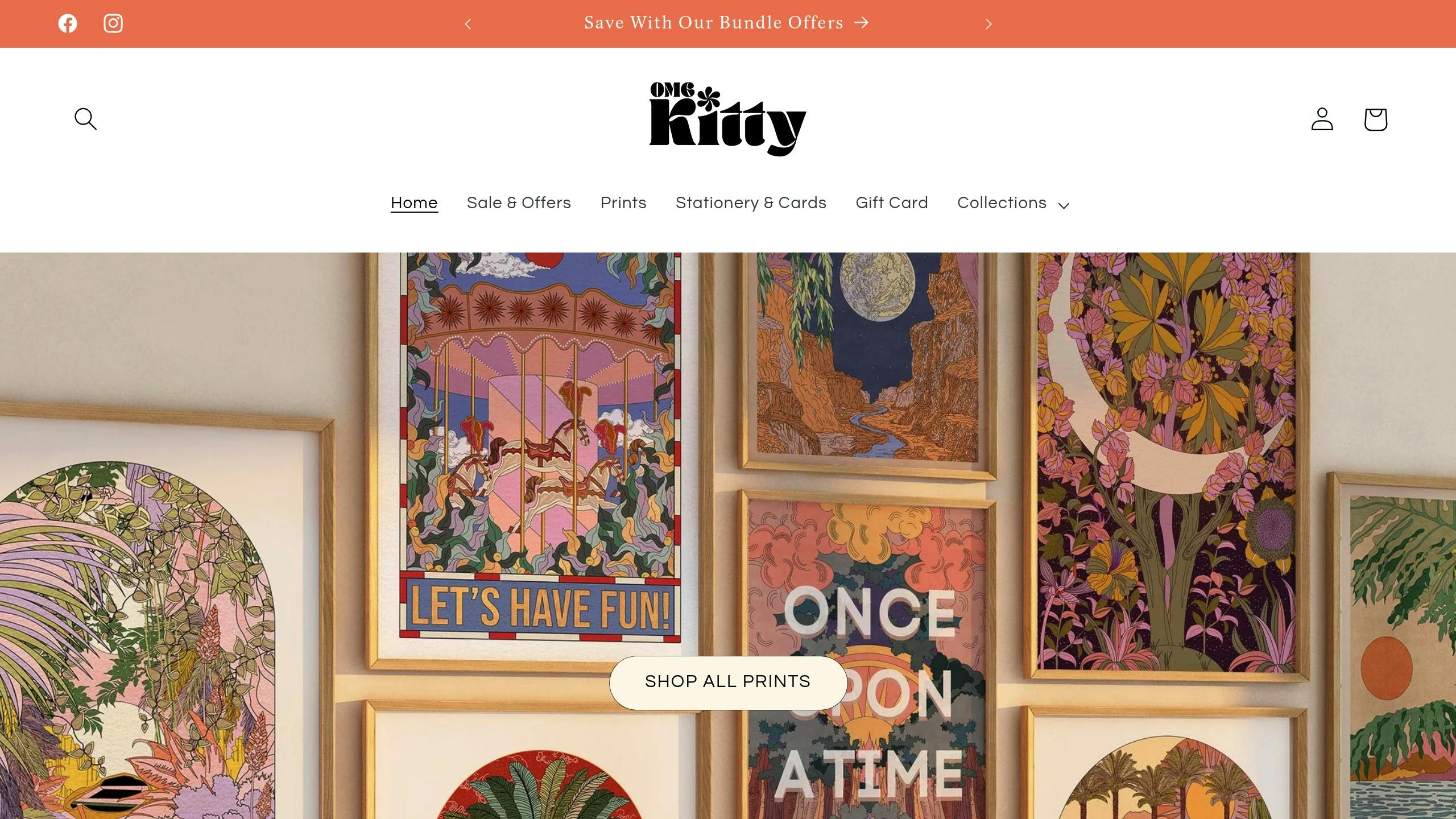Measuring artwork accurately ensures it fits perfectly in your space or frame. Here's what you need to know:
- Tools Needed: Use a metal measuring tape, acrylic ruler, and carpenter's square with 1/16-inch precision.
- For Unframed Prints: Measure the height and width of the artwork, including or excluding borders as needed.
- For Framed Prints: Focus on the visible image area, mat borders, and frame depth.
- Key Differences: Framed prints require outer dimensions and depth, while unframed prints focus on paper or image size.
Quick Comparison Table:
| Measurement Component | Unframed Print | Framed Print |
|---|---|---|
| Artwork Size | Full dimensions | Visible area |
| Mat Opening | Not applicable | Smaller by 0.5" |
| Frame Overlap | Not applicable | 1/4" on each side |
| Total Wall Space | Print size | Outer frame dimensions |
Accurate measurements prevent gaps, ensure polished displays, and help you choose the right frame or space for your artwork.
How to Measure Your Artwork for Framing
How to Measure Art Prints
Accurate measurements are key when working with art prints. Here's how to get it right.
Tools You'll Need
Grab a metal measuring tape for large prints, a clear acrylic ruler for smaller details, and a carpenter's square to check angles. Make sure your tools have precise 1/16-inch markings for accuracy [3]. Keep a pencil, notepad, and calculator nearby for jotting down numbers and handling any conversions [1][2].
Measuring Unframed Prints
Follow these steps to measure unframed prints:
- Lay the artwork flat on a clean, even surface.
- Start measuring from the second inch mark on your ruler to ensure straight, precise readings [3].
- Measure the height (top to bottom) and width (left to right).
- If the print has borders or deckled edges, decide whether to include them in your measurements and make a note of it.
- Record dimensions down to the nearest 1/16 inch [3].
For prints with irregular shapes, measure the longest and widest points [3].
Measuring Framed Prints
When dealing with framed prints, focus on these areas:
- Measure the visible image area inside the mat opening.
- Measure each of the mat borders individually.
- Record the frame's depth from the front to the back.
| Measurement Component | Include This |
|---|---|
| Image Area | Only the part of the artwork you can see |
| Mat Border | All four sides, measured separately |
| Frame Depth | The distance from the front to the back of the frame |
These steps will help ensure your measurements match standard frame sizes or custom options, like those available from OMG Kitty.
Framed vs. Unframed Measurement Guide
Knowing how to measure framed and unframed artwork is essential for proper display and fitting. Here’s a breakdown of what you need to know for each type.
Frame Measurement Basics
When measuring framed artwork, focus on the outer dimensions (height and width from the outer edges) and the depth of the frame. These measurements ensure consistent spacing from walls, which is especially important for achieving a gallery-style look.
Unframed Print Measurements
For unframed prints, make sure to note both the image size and the paper size (including any borders). If the print includes bleed areas, account for the standard bleed margins [3]. To ensure accuracy, take measurements in multiple spots, as paper can sometimes be uneven.
Measurement Comparison Chart
Here’s a quick reference to highlight the differences between framed and unframed artwork:
| Measurement Component | Unframed Print | Framed Print (with 2" mat) |
|---|---|---|
| Artwork Size | Actual print dimensions | Same as unframed |
| Mat Opening | N/A | 0.5" smaller than artwork |
| Frame Overlap | N/A | 1/4" on each side [3] |
| Visible Area | Full print size | Mat opening size |
| Total Wall Space | Print dimensions | Frame outer dimensions |
| Depth Consideration | Paper thickness only | Frame depth (usually 1-3") |
This chart helps you understand how dimensions differ and guides you in choosing the right display locations - details we’ll dive into next.
sbb-itb-78c8b21
Display Tips Using Measurements
Once you have accurate measurements, use these ideas to fine-tune your art placement.
Choosing the Right Print Sizes for Your Space
Align print sizes with both the furniture and the wall's scale. A good rule: artwork should be two-thirds to three-quarters the width of the furniture beneath it.
Here’s a quick guide based on room size:
| Room Size | Suggested Art Dimensions |
|---|---|
| Small (less than 200 sq ft) | 11" x 14" to 18" x 24" |
| Medium (200-300 sq ft) | 24" x 36" |
| Large (over 300 sq ft) | 36" x 48" or larger |
Aim to fill 60-75% of the wall space to create a strong visual effect [6].
Avoiding Common Measurement Mistakes
Measurement errors can throw off your display. Look out for these issues:
- Frame Depth: Don’t forget to consider the depth of the frame, especially in tight spaces, to avoid clearance issues [5].
- Center Point Misalignment: The ideal viewing height places the center of your artwork 57-60 inches from the floor [1].
- Furniture Spacing: Maintain a gap of 4-8 inches between the bottom of the frame and the top of your furniture [1].
Using Digital Tools for Layout Planning
Tech tools can help you plan with precision. Apps like ArtPlacer let you visualize how artwork will look in your space, while WallApp uses augmented reality to preview designs and catch potential errors.
For gallery walls, these tools ensure you keep the recommended 2-3 inch spacing between frames [1], resulting in a polished, well-balanced arrangement.
Pro tip: Larger pieces can brighten darker rooms by creating a sense of openness.
Made-to-Order Print Options
Getting the right measurements is crucial when ordering custom-sized prints. Knowing your options ensures your artwork fits perfectly in your chosen space.
Why Choose Custom Sizing?
Custom-sized prints let you tailor dimensions to your exact needs. This means you can:
- Fit artwork into unusual spaces
- Avoid the hassle of resizing frames
- Cut down on unnecessary material use
These features make custom sizing a smart choice, especially for OMG Kitty's made-to-order service. It’s a practical solution for challenges like:
- Alcoves needing precise width
- Oversized pieces for statement walls
- Maintaining consistent proportions in gallery arrangements
OMG Kitty Print Services

OMG Kitty provides prints with precise sizing options, ranging from A4 to A1, making it easy to find the right fit for your space:
- A4: Great for smaller spaces or cozy wall sections
- A3: Works well for medium-sized walls
- A2: Perfect for statement pieces in average-sized rooms
- A1: Best for large walls or creating a focal point
Their production process focuses on eco-conscious practices, including on-demand printing, sustainable materials, and UK-based production to lower environmental impact. Precise sizing also helps reduce waste during production.
Orders are produced within 1-3 business days before shipping.
Summary
Getting precise measurements is key to making sure your OMG Kitty prints look perfect, whether they're framed or unframed. Here's a quick guide to the important steps for measuring your artwork and what to do next.
Key Measurement Steps
Follow these steps to ensure accurate results:
- For unframed prints, measure the actual edges of the artwork.
- For framed pieces, focus on the visible area inside the frame [1][2].
- When working with canvas prints, measure at several points to double-check accuracy [3].
- Always record measurements to the nearest 1/16 inch using a measuring tape with clear markings [3].
| Print Type | Focus of Measurement |
|---|---|
| Unframed | Artwork edges |
| Framed | Visible area inside the mat |
Next Steps for Print Purchase
OMG Kitty's sizing options are designed to match these measurements. Here's what to do next:
- Check that the artwork and frame depth are compatible.
- Pick an OMG Kitty size that fits your measurements.
- Select hanging hardware that supports the combined weight of the print and frame.
Their A4-to-A1 sizing options are made to order, so your artwork will fit perfectly in any space you have in mind.
FAQs
How to choose mat size for art?
To determine the right mat size, aim for a width that's about 1.5 times the size of your frame molding. For instance, if your frame is 1" wide, a mat width of 1.5" works well. This method complements the frame measurement tips discussed earlier, ensuring your artwork fits seamlessly within your planned wall space.
Here’s a handy reference for common artwork sizes and their suggested mat widths:
| Artwork Size | Minimum Mat Width | Maximum Mat Width |
|---|---|---|
| 8" x 10" | 2" | 4" |
| 11" x 14" | 2.5" | 5" |
| 16" x 20" | 3" | 6" |
Key tips to keep in mind:
- Make the bottom mat 10% wider for better visual balance.
- Use acid-free mats to protect your artwork from damage over time [1].
- Keep mat sizes consistent in multi-piece displays for a cohesive look.
- Layer mats with contrasting colors to create depth [4].
- Remember, mat width directly affects the total frame size, so factor this into your wall space measurements.
Layered mats are a great way to add depth and contrast to your display [4]. Consistent mat sizes also help maintain alignment with gallery wall spacing, as covered earlier. Oversized mats have become a popular choice for modern art displays [2].

